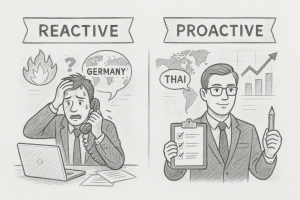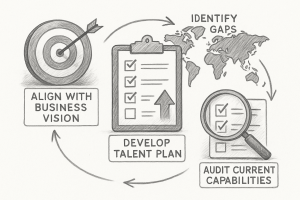For decades, many businesses have treated language skills as an afterthought. A new client is signed in Germany, sparking a frantic search for a German speaker. An opportunity arises in Brazil, leading to a rushed and costly reliance on translation services. This reactive, “firefighting” approach to language is inefficient, risky, and can actively hinder growth.
Today, leading HR professionals are rewriting this playbook. They are evolving from reactive problem-solvers into strategic business partners by embracing a powerful new discipline: Proactive Language Needs Analysis (LNA). This isn’t just about managing languages; it’s about anticipating future business requirements and strategically aligning your company’s linguistic capabilities to meet them head-on. It’s the difference between being caught off guard and being two steps ahead of the competition.
As global expansion accelerates and AI translation tools still fall short in nuance and cultural fluency, the demand for human-level linguistic precision in business is sharper than ever. HR leaders must now predict—not just respond to—future communication needs to stay competitive. Conducting a language audit gives you data-driven insight into your workforce’s multilingual capabilities, helping shape international communication planning and talent readiness.
The shift from reactive measures to proactive strategy
The old way of handling language needs is fraught with peril. It leads to:
- Missed opportunities: the perfect business deal won’t wait for you to find a translator.
- Inflated costs: urgent, last-minute hiring and external language services come at a premium.
- Poor hires: rushed recruitment often leads to compromising on the quality of a candidate.
- Project delays: communication bottlenecks can stall critical projects and frustrate international teams.
A proactive approach turns this entire model on its head. By partnering with business leaders to look 1, 3, or even 5 years into the future, HR can build a talent strategy that ensures the right people with the right language skills are ready before the need becomes critical.
Why proactive language analysis is a business imperative
Integrating a Proactive LNA into your strategic planning process yields significant, tangible benefits across the organization:
- It underpins strategic growth: if the 5-year business plan involves expansion into Southeast Asia, a proactive LNA ensures you start building your Thai and Vietnamese language capabilities now, not when you’re trying to sign the first contract.
- It optimizes your entire talent strategy: the insights from an LNA inform every aspect of HR:
- Recruitment: you know exactly which language skills to prioritize in new hires.
- Learning & Development: you can design targeted upskilling programs for current employees.
- Succession planning: you can ensure your future leaders have the linguistic skills to manage global teams.
- Internal mobility: you can identify and prepare employees for international assignments and roles.
- It reduces costs and mitigates risk: by anticipating needs, you reduce reliance on expensive emergency solutions and avoid the risk of communication failures that can derail major initiatives or damage client relationships.
Your step-by-step guide to a proactive language needs analysis
Conducting an LNA is a structured process that transforms HR into a true strategic partner.
Step 1 – align with the business vision:
This is the foundational step. Sit down with C-suite executives and leaders from Sales, Marketing, and Operations. Understand the company’s strategic roadmap. Where are we planning to grow? Which new markets are we targeting? Who will our customers, partners, and competitors be in the coming years?
Step 2 – audit your current capabilities (the language census):
You cannot plan a journey without knowing your starting point. This involves systematically mapping the existing language skills across your entire organization. It’s not enough to simply ask, “Who speaks Spanish?” – you need to understand their level of professional proficiency using a standardized framework like the CEFR (Common European Framework of Reference for Languages). This provides an objective baseline of your current linguistic assets.
Step 3 – identify the critical gaps:
With a clear picture of future needs (Step 1) and current capabilities (Step 2), you can perform a gap analysis. This is where the strategic insights emerge. You might discover, for example, that your company has strong European language skills but is critically unprepared for a planned expansion into the Middle East.
Step 4 – develop your talent plan:
The gap analysis dictates your action plan. This will be a multi-pronged strategy that includes:
- Upskilling: identify high-potential current employees for targeted language training.
- Hiring: adjust your external recruitment strategy to actively source candidates with the required language skills.
- Retaining: implement measures to recognize and retain employees who possess business-critical language skills.
Step 5 – review, iterate, and adapt:
A Proactive LNA is not a one-time project; it is a living part of your strategic HR cycle. This analysis should be reviewed and updated annually, or whenever there is a significant shift in business strategy, to ensure it remains relevant and effective.
Speak the language of the future
In a globalized world, language is a core business asset, not an administrative task. By embracing a proactive approach to language needs analysis, you can secure a vital seat at the strategic table. You move from being a service provider to being a strategic architect of the company’s future, ensuring that your organization is always ready to speak the language of its next big opportunity.
Key benefits of proactive LNA:
- Anticipates language gaps before they slow business
- Guides smarter recruitment and upskilling
- Prevents costly last-minute fixes
- Aligns HR with long-term corporate vision
- Builds global team readiness
Ready to shift from reactive support to strategic HR leadership?
A proactive language needs analysis begins with one crucial step: understanding the skills you already have. Start with a Focus Audit Tool language assessment. We help you map your team’s current language capabilities using the CEFR standard—so you can build a future-proof multilingual workforce that’s always ready for what’s next.





